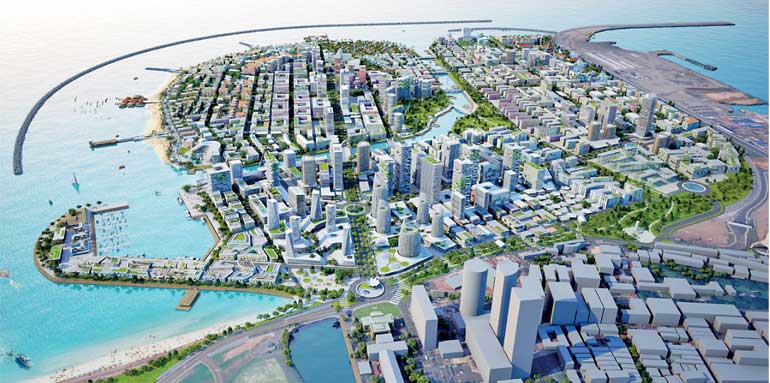Wednesday Dec 17, 2025
Wednesday Dec 17, 2025
Tuesday, 22 December 2015 00:01 - - {{hitsCtrl.values.hits}}
According the recently released Supplementary Environmental Impact Assessment (SEIA) report, the Colombo Port City (CPC), upon completion of reclamation works, will incorporate solutions for integrated management of energy, water and waste towards long‐term environmental sustainability and the creation of a comfortable environment for its occupants, according to an eco‐cycle concept.
The eco‐cycle model describes the interaction between reduced demand‐side and highly developed supply systems. The overall goal is to reduce the negative environmental impact from the Port City’s emissions of greenhouse gases and pollutants. In order to achieve these goals the eco‐cycle systems will contribute to the lowest possible demand of electricity and fossil fuel for transport; the lowest possible demand of fresh water in buildings and public areas; and lower demand of energy for heating and cooling. It will also include high quality recycling of water, energy, material and plant nutrients, and interaction between functional demand side solutions and the overall infrastructure.

The Port City’s eco‐cycle concept requires integration with the existing and future plans and implementation strategies of the Government of Sri Lanka and the Ministry of Megapolis and Western Development, in order to realise its full potential and benefits. Therefore, constant and effective dialogue and co-operation between all stakeholders are essential.
The power requirement for the CPC will be a based on the rate of development that will take place on the reclaimed land.
The overall strategy of the CPC is to secure electricity supply during the building phases and during the operational phase, and to reduce the dependency on fossil fuels in order to reduce environmental impact. This will be achieved through a combination of minimising cooling demand through energy efficient building design (solar shading etc.); using solar heaters and Photovoltaic cells on roof‐tops; and a well‐designed electricity grid design to minimise impact of grid failure.
The Ceylon Electricity Board (CEB) has recognised that the greater Colombo and Colombo Business District (CBD) area will have a rapidly increasing electricity demand as a consequence of investments and developments such as Shangri‐La, ITC hotels and the Port City. Consequently, the GOSL has entered into an agreement (SL‐P107) with Japan International Corporation Agency (JICA) to obtain a soft loan under the Japanese Official Development Assistance (ODA) scheme for funding several projects to cater to the above requirements.
Under this project, the capacity of the greater Colombo power network will be doubled through a new 220kV underground transmission cable network. Further, the project would improve the existing power network by construction of four new grid substations, augmentation of five existing grid substations, laying of 37.7 km of underground transmission cables, laying of 92 km of underground distribution cables and installation of 86 new 11kV distribution panels.
The CEB has confirmed that it would construct a new 500MVA new primary substation at Chaitya Road. The tender for the construction of the substation is targeted to be finalised before end of 2015.
Commissioning of the substation is scheduled by end 2019. Up to 250MVA from the completed substation is to be allocated to the CPC.